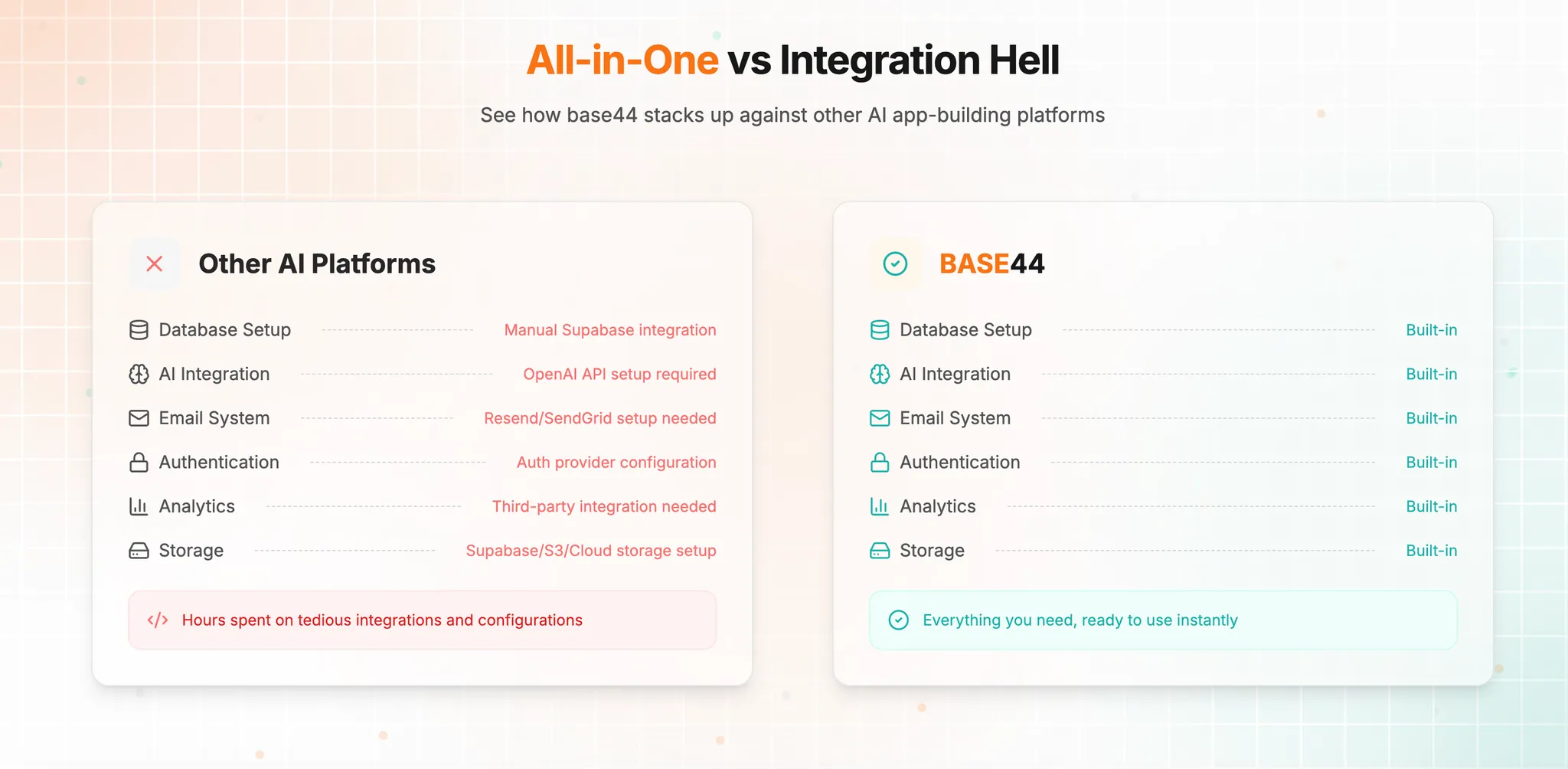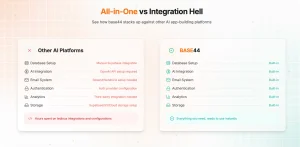The Best No-Code Tool You’re Not Using Yet: A Deep Dive on Base44
The no-code revolution has transformed how we build applications, automate workflows, and create digital solutions. While most developers and entrepreneurs are familiar with household names like Zapier, Airtable, and Webflow, there’s a powerful platform flying under the radar that deserves your attention: Base44.
What Makes Base44 Different?
Base44 positions itself as more than just another no-code platform—it’s a comprehensive ecosystem that bridges the gap between simple drag-and-drop builders and complex custom development. Unlike traditional no-code tools that force you to work within rigid templates, Base44 offers unprecedented flexibility while maintaining the simplicity that makes no-code appealing.
The Philosophy Behind Base44
At its core, Base44 operates on the principle that powerful software shouldn’t require a computer science degree to build. The platform was designed by developers who understood the frustrations of both technical and non-technical users. They wanted to create something that could scale from simple prototypes to enterprise-level applications without forcing users to migrate to different platforms.
Key Features That Set Base44 Apart
1. Advanced Database Management
While most no-code tools treat databases as an afterthought, Base44 puts data at the center of everything. The platform offers sophisticated relational database capabilities that rival traditional SQL databases, but with a visual interface that makes complex queries feel intuitive.
You can create multiple interconnected tables, establish foreign key relationships, and even implement complex business logic through visual rules. The database layer is so robust that many users report using Base44 solely for data management, even when building their frontend elsewhere.
2. Intelligent Automation Engine
Base44’s automation capabilities go beyond simple “if this, then that” logic. The platform includes an intelligent automation engine that can handle multi-step workflows, conditional branching, and even machine learning-powered decision making.
What’s particularly impressive is how these automations can interact with external APIs, process files, send notifications, and update multiple systems simultaneously. The visual workflow builder makes it easy to see the entire automation process at a glance, while advanced users can dive into custom code when needed.
3. Seamless API Integration
One of Base44’s strongest selling points is its API-first approach. The platform treats every function as an API endpoint, which means your Base44 applications can easily integrate with existing systems, third-party services, and custom applications.
The API documentation is automatically generated and always up-to-date, making it simple for technical team members to integrate Base44 applications into larger ecosystems. This approach ensures that you’re never locked into the platform and can always extend functionality as needed.
4. Collaborative Development Environment
Base44 shines in team environments. The platform includes real-time collaboration features that allow multiple users to work on the same project simultaneously. Version control is built-in, so you can track changes, revert to previous versions, and manage different development branches.
The permission system is granular enough to give different team members appropriate access levels, from view-only permissions for stakeholders to full administrative access for project leads.
Real-World Applications
Small Business Operations
Many small businesses use Base44 to replace multiple SaaS subscriptions with a single, integrated solution. A typical implementation might include customer relationship management, inventory tracking, project management, and financial reporting—all within one cohesive system.
Enterprise Process Automation
Large organizations leverage Base44 to automate complex business processes that previously required custom development. The platform’s ability to handle enterprise-scale data volumes and integrate with existing systems makes it an attractive alternative to expensive custom solutions.
Rapid Prototyping
Startups and product teams use Base44 to quickly validate ideas and build minimum viable products. The platform’s flexibility allows for rapid iteration based on user feedback, while its scalability ensures that successful prototypes can evolve into full-featured applications.
The Learning Curve
While Base44 is designed to be accessible to non-technical users, it does have a steeper learning curve than some simpler no-code tools. However, this complexity comes with significant benefits. Users who invest time in learning the platform’s capabilities often find they can build more sophisticated applications than they ever thought possible without coding.
The platform offers comprehensive documentation, video tutorials, and an active community forum. Most users report being productive within a few days of starting, though mastering the advanced features can take weeks or months.
Pricing and Value Proposition
Base44’s pricing model is competitive with other enterprise-grade no-code platforms, but the value proposition is compelling. The platform’s ability to replace multiple tools and services often results in significant cost savings, even when accounting for the learning curve investment.
The free tier is generous enough for individuals and small teams to build meaningful applications, while enterprise plans offer the scalability and security features required for large-scale deployments.
Potential Drawbacks
No platform is perfect, and Base44 has some limitations to consider. The interface can feel overwhelming for users accustomed to simpler tools, and the extensive customization options can lead to analysis paralysis for some users.
Additionally, while the platform is highly capable, it may be overkill for simple projects that could be handled by lighter-weight tools. The key is matching the tool to the complexity of your requirements.
The Future of Base44
The platform’s roadmap includes exciting developments in artificial intelligence integration, advanced analytics capabilities, and enhanced mobile app development features. The team behind Base44 has consistently delivered on their promises, suggesting that the platform will continue to evolve and improve.
Should You Try Base44?
If you’re currently using multiple no-code tools or struggling with the limitations of simpler platforms, Base44 deserves serious consideration. The platform is particularly well-suited for:
- Teams that need to build complex, interconnected applications
- Organizations looking to automate sophisticated business processes
- Developers who want the speed of no-code with the flexibility of custom development
- Businesses that require extensive API integrations and custom workflows
Getting Started
The best way to evaluate Base44 is to start with a small project that showcases the platform’s strengths. Consider building a simple database application with some automation features, then gradually expand as you become more comfortable with the platform’s capabilities.
The Base44 community is welcoming and helpful, making it easy to get answers to questions and learn from others’ experiences. Many users recommend starting with the platform’s tutorial series, which provides a solid foundation for more advanced features.
Conclusion
Base44 represents the next evolution of no-code platforms—powerful enough for complex applications, yet accessible enough for citizen developers. While it may not replace every tool in your arsenal, it has the potential to consolidate many of them while providing capabilities you didn’t know you needed.
The no-code landscape is crowded, but Base44 has carved out a unique position by focusing on power users who need more than simple drag-and-drop functionality. If you’re ready to take your no-code development to the next level, Base44 might just be the platform you’ve been waiting for.
Ready to explore Base44 for yourself? Start with their free tier and see how this powerful platform can transform your approach to application development and process automation.



